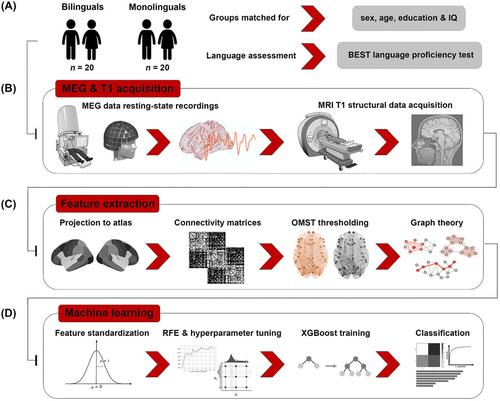当前位置:
X-MOL 学术
›
Ann. N. Y. Acad. Sci.
›
论文详情
Our official English website, www.x-mol.net, welcomes your feedback! (Note: you will need to create a separate account there.)
Decoding bilingualism from resting-state oscillatory network organization
Annals of the New York Academy of Sciences ( IF 5.2 ) Pub Date : 2024-02-28 , DOI: 10.1111/nyas.15113 Lucia Amoruso 1, 2, 3 , Adolfo M. García 3, 4, 5 , Sandra Pusil 6 , Polina Timofeeva 1, 7 , Ileana Quiñones 1, 2 , Manuel Carreiras 1, 2, 7
Annals of the New York Academy of Sciences ( IF 5.2 ) Pub Date : 2024-02-28 , DOI: 10.1111/nyas.15113 Lucia Amoruso 1, 2, 3 , Adolfo M. García 3, 4, 5 , Sandra Pusil 6 , Polina Timofeeva 1, 7 , Ileana Quiñones 1, 2 , Manuel Carreiras 1, 2, 7
Affiliation

|
Can lifelong bilingualism be robustly decoded from intrinsic brain connectivity? Can we determine, using a spectrally resolved approach, the oscillatory networks that better predict dual-language experience? We recorded resting-state magnetoencephalographic activity in highly proficient Spanish-Basque bilinguals and Spanish monolinguals, calculated functional connectivity at canonical frequency bands, and derived topological network properties using graph analysis. These features were fed into a machine learning classifier to establish how robustly they discriminated between the groups. The model showed excellent classification (AUC: 0.91 ± 0.12) between individuals in each group. The key drivers of classification were network strength in beta (15–30 Hz) and delta (2–4 Hz) rhythms. Further characterization of these networks revealed the involvement of temporal, cingulate, and fronto-parietal hubs likely underpinning the language and default-mode networks (DMNs). Complementary evidence from a correlation analysis showed that the top-ranked features that better discriminated individuals during rest also explained interindividual variability in second language (L2) proficiency within bilinguals, further supporting the robustness of the machine learning model in capturing trait-like markers of bilingualism. Overall, our results show that long-term experience with an L2 can be “brain-read” at a fine-grained level from resting-state oscillatory network organization, highlighting its pervasive impact, particularly within language and DMN networks.
中文翻译:

从静息态振荡网络组织中解码双语
能否从内在的大脑连接中可靠地解码终生双语?我们能否使用光谱解析方法确定更好地预测双语言体验的振荡网络?我们记录了高度熟练的西班牙语-巴斯克双语者和西班牙语单语者的静息态脑磁活动,计算了规范频段的功能连接,并使用图形分析导出了拓扑网络属性。这些特征被输入到机器学习分类器中,以确定它们区分各组的稳健程度。该模型在每组个体之间显示出出色的分类(AUC:0.91 ± 0.12)。分类的关键驱动因素是 beta(15-30 Hz)和 delta(2-4 Hz)节律的网络强度。对这些网络的进一步表征揭示了颞叶、扣带回和额顶叶中枢的参与可能支撑着语言和默认模式网络(DMN)。相关性分析的补充证据表明,在休息时更好地区分个体的顶级特征也解释了双语者第二语言(L2)熟练程度的个体间差异,进一步支持机器学习模型在捕获双语特征样标记方面的稳健性。总体而言,我们的结果表明,L2 的长期经验可以在静息态振荡网络组织的细粒度水平上“被大脑读取”,突出了其普遍影响,特别是在语言和 DMN 网络中。
更新日期:2024-02-28
中文翻译:

从静息态振荡网络组织中解码双语
能否从内在的大脑连接中可靠地解码终生双语?我们能否使用光谱解析方法确定更好地预测双语言体验的振荡网络?我们记录了高度熟练的西班牙语-巴斯克双语者和西班牙语单语者的静息态脑磁活动,计算了规范频段的功能连接,并使用图形分析导出了拓扑网络属性。这些特征被输入到机器学习分类器中,以确定它们区分各组的稳健程度。该模型在每组个体之间显示出出色的分类(AUC:0.91 ± 0.12)。分类的关键驱动因素是 beta(15-30 Hz)和 delta(2-4 Hz)节律的网络强度。对这些网络的进一步表征揭示了颞叶、扣带回和额顶叶中枢的参与可能支撑着语言和默认模式网络(DMN)。相关性分析的补充证据表明,在休息时更好地区分个体的顶级特征也解释了双语者第二语言(L2)熟练程度的个体间差异,进一步支持机器学习模型在捕获双语特征样标记方面的稳健性。总体而言,我们的结果表明,L2 的长期经验可以在静息态振荡网络组织的细粒度水平上“被大脑读取”,突出了其普遍影响,特别是在语言和 DMN 网络中。



























 京公网安备 11010802027423号
京公网安备 11010802027423号